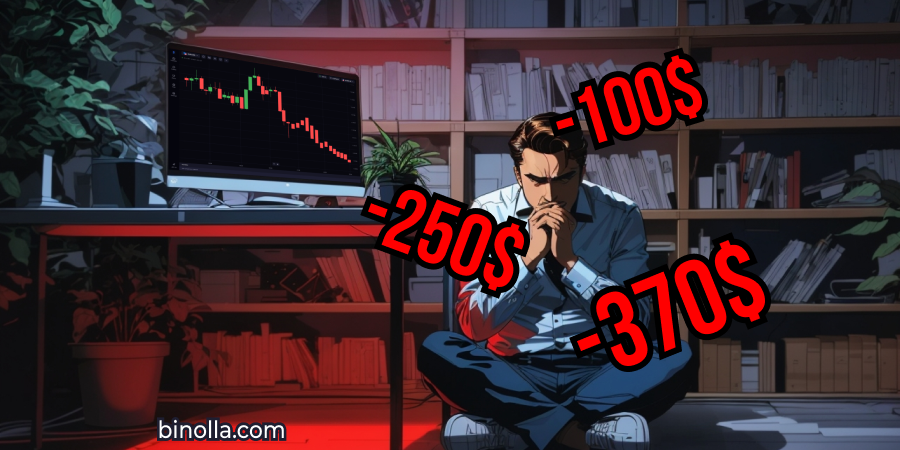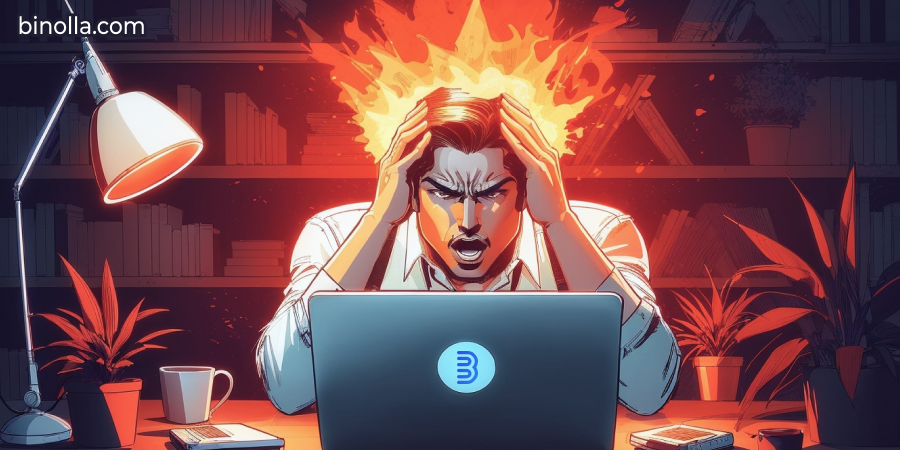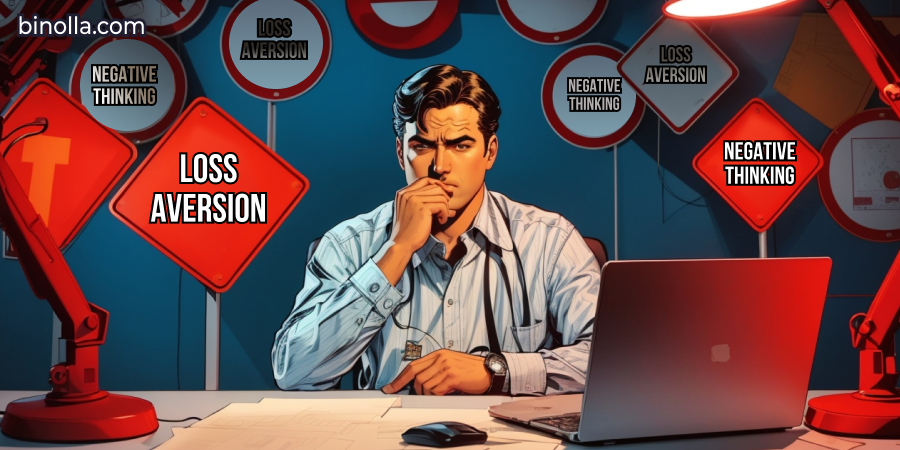Understanding Loss Aversion: How Fear of Loss Impacts Trading Decisions

Loss aversion is a part of behavioral finance describing situations when traders and investors fear losses more than they aspire to make gains. While most traders focus on tackling the negative impact of emotions, understanding and dealing with loss aversion should be among the top priorities. Whether you are trading digital options or Forex CFDs, overcoming such nuances is crucial for success. This article navigates you through loss aversion and the main techniques you can use to mitigate the negative influence of this emotional state on your trading.
Those willing to try their strategies can create an account at Binolla and start trading right now!
Contents
Loss Aversion Basics
The term “Loss Aversion” was first used by Amos Tversky and Daniel Kahneman in 1979 as part of a theory that later brought Kahneman a Nobel prize. The idea of the theory designed by these prominent scientists and psychologists was that while we make rational trading decisions based on self-interest, some aspects, including loss aversion may have a significant impact on what we do in trading and investment.
How is this theory related to trading? A trader feels a heavier pain when thinking about losses than when enjoying profits of the same size. For instance, if you think that you are going to lose $100 the emotional pain will be harder as compared to the joy that you will feel when thinking about making $100.
Loss Aversion Reasons

This behavior is caused by many reasons. Some of them have psychological roots while others are connected with market and social factors. The key ones are presented in the following list:
- Psychology. Human brains prioritize survival, which means that we focus on avoiding losses more than on making gains;
- Emotions. Losing money is stressful and causes negative emotions. When losing money, market participants may feel regret or anxiety;
- Anchoring and confirmation. Some cognitive biases can also contribute to loss aversion. Confirmation may lead to situations when traders look for confirmation of their beliefs. For instance, traders may want some proof of their beliefs that an asset will rise. They will definitely find them, but it has nothing to do with real market movements. Anchoring causes traders to stick to a particular price. However, when market conditions change, it is difficult for market participants to adjust to changing market conditions;
- Volatility. Another reason for loss aversion is market volatility. Emotional decisions related to higher volatility may lead to heavier losses. The fear of losses may also lead to loss aversion as market participants may stick to losing positions hoping that the price will reverse in the favorable direction.
Examples of Loss Aversion in Trading
There are plenty of examples of loss aversion in trading that every trader has experienced at least once in their career. We have put together some of them in the following lines:
- Imagine that a trader buys a CFD for EUR/USD at 1.0800. At some moment, the currency pair starts to fall. At this very moment, loss aversion comes into play as the trader becomes too attached to their losing position. They can’t be objective anymore and even clear signs of a strong bearish trend can’t change their view and close the position in order to avoid heavier losses. The trader decides to hold their trade. EUR/USD plunges deeper and the losses grow;
- In another example of loss aversion a trader sells GBP/USD, but the price goes in the opposite direction. Instead of cutting losses when the acceptable level of risk is reached, the trader starts to open other trades, i.e. their behavior becomes aggressive. They want to compensate for the losses from the first trade, but the situation goes out of control, and instead of covering losses, the trader finds themselves in an even more complex situation. Apart from losses, this leads to higher transaction costs;
- Finally, let’s consider another example. A trader decides to buy the AUD/USD currency pair. However, the price goes in the opposite direction. The position is closed, but from now on, all decisions that the trader makes are based on their fear rather than analysis.
As you can see, having knowledge in technical analysis is not enough for a trader to succeed. Even if you have curbed one of the analysis tools or even several ones, there is no guarantee that you will succeed until you manage to deal with your emotions and loss aversion. Now we are going to provide you with some recommendations on how to overcome loss aversion in trading.
Signs of Loss Aversion and Negative Thinking

Loss aversion as well as negative thinking can be detected by a trader. The following signs will tell you that something is wrong with your emotional state:
- Negative thoughts about yourself, other people, and the future;
- Despair about the future;
- You can hardly communicate with the relatives;
- The level of interest in what made you happy in the past is significantly lower;
- Emotional numbness;
- Change of physical and emotional reactions.
Loss Aversion: How to Mitigate Your Risks in Trading

Loss aversion is not a sentence. Even if you have suffered from it, you still can change everything and minimize its impact on your trades. Here is how to fight loss aversion to improve your trading results.
Think About Exits
Unlike digital options traders whose exits are predetermined by expiration, Forex CFD traders should always think about when they are going to close their positions. This is relevant for both losses and profits. If the price moves in the opposite direction, you should know where to cut your losses in order to mitigate the risks of heavier losses, while in the case of a profitable trade, you should think about where to close this position to get the most out of it.
One important thing to know here is that you should stick to what you have planned in advance in any case. When you plan exits in a calm psychological state, you are more objective than ever. If you decide to change the rules when the trade is opened, your decisions are emotional and they may lead to unpredictable consequences. Therefore, even if you can’t impact the price fluctuations, you still can have control over your balance by thinking in advance about the losses that you can afford and the profits that you should take in a particular trade.
Use Stop Loss Orders
Using stop losses and take profit orders will help you deal with loss aversion. Those who trade Forex CFDs often neglect this option thinking that they will close the trade manually. However, placing stop losses and take profit orders in advance during the process of placing a trade may save your day. The thing here is not to move them once placed! Many traders change the rules during the trades as they are extremely attached to their positions and do not want losses to occur.
Moving stop losses is a very bad idea as by doing this, you undermine all your previous efforts and calculations. Therefore, you can have even heavier losses that will lead to higher risks of loss aversion. The only case when you can move your stop loss is when the price goes in the direction of your forecast. By doing this, you can lock your profits, but you should be careful when doing this as the price may have a correction and hit your modified stop loss before your trading goals are achieved.
Focus on Long-Term Goals

Trading is not about short-term gains. Even if you are trading 5s scalping contracts in digital options, you still need to have long-term goals in order to become a successful trader. This means that you should think about how much you want to make over time. Focusing on short-term success or failure will develop loss aversion.
The long-term perspective helps traders mitigate the risks of being attached to losses. It will shift your focus from short-term failures to long-term growth. While you still need to document your trades and work on your trading mistakes, you should think about your long-term opportunities in order to have better control of your emotions.
While losses are an inevitable part of trading, you should think about how much you can gain over months and even years. By doing this, you will be able to minimize the risks of loss aversion and have a better perspective of what you can achieve over time.
Review Your Trading Sessions
While it may be painful to review some trades, you should do it for several reasons. First, in order to review your mistakes to avoid them in the future. Every strategy needs adjustments from time to time. By reviewing your losing trades, you can better understand the bottleneck of your strategy and change some parameters to improve its performance.
Next, you may also need to adjust your money and risk management approach (for Forex CFD traders only). If your losses exceed your gains, then something is wrong with your reward-to-risk ratio. Professional Forex CFD traders often use a 1:2 or 1:3 ratio to be successful over time.
Stop Winding Yourself Up

While losses are inevitable in trading, you can still deal with them. By winding yourself up, you are unlikely to improve your results. Moreover, you are more likely to make everything even worse as you will be unable to control your emotions.
We would like to make a couple of suggestions that will definitely help you to “survive” losses and stop winding yourself up:
- First, you should write down what and when it happened. For instance, you have bought EUR/USD at 1.0900 and the currency pair plunged instead of growing. Then, you can write that the currency pair moved in the opposite direction and you have lost 50 pips, for example, which is equal to $500;
- Then, read everything that you have written in the previous step. This will help you keep it real and mitigate risks of emotional reactions or irrational moves;
- Think about what has happened and what the advantages of the situation are. While it may seem illogical to speak about the positives of a loss in trading, some benefits you may definitely pinpoint. For instance, the trade has revealed that your strategy needs an adjustment, or you opened an irrational trade based on your guts and not on the current market situation;
- When having a loss, think about all these profitable traders and investors who had and still have losses. Alexandr Elder, for instance, says that he had both positives and painful negatives on his way to success. He lost much money and even thought about leaving trading, but found enough will to stay and continue to fight. Nowadays, this is one of the most successful traders having his own strategy;
To improve your trading results and mitigate risks of loss aversion, you should do the following:
- Ask for help from your relatives. Let them tell you about your best qualities. This will likely help you rebuild your confidence;
- Take a pause. If you feel that loss aversion affects your trading, then take a pause and switch to other activities;
- Calculate your profit and losses. By doing this, you will stay realistic about your trading outcomes and will better manage your funds.
David Deutsch Rules

The famous British scientist has offered several rules to help people deal with negative emotions. They can be applied to any activities, including digital options and Forex trading. The key three ones are presented below:
- The first rule says that problems are inevitable and you need to admit them. If you are in trouble it doesn’t mean that the whole world is collapsing. Issues accompany us throughout our lives;
- The second rule says that all issues can be solved. If the solution does not contradict nature’s laws, then you can find it when having the necessary knowledge. Therefore, instead of being stuck, you need to deepen your knowledge and learn from your mistakes. Making mistakes is normal and they teach us a lot;
- Each solution creates new issues that, in turn, require solutions. In trading, after you have closed a profitable trade, you have solved one problem. However, with every next position, new problems may arise and you have to learn how to deal with them.
Practice Emotional Control
You can’t eliminate emotions from trading. Feeling bad after one loss is inevitable. Even if you know how to control your emotions, you will feel sad after closing a position with a negative balance. However, you can still keep emotions out of your trading activities. There are a lot of techniques that will help you make rational decisions in trading instead of buying and selling randomly trying to get as much money as possible or, alternatively, trying to win back what you have previously lost.
Some of techniques may include meditation or deep breathing. However, we would recommend using stop losses as well (that was already mentioned above). By doing this, you know in advance how much you can lose per trade. If you are good with this amount, then your decisions will be less influenced by emotions.
Otherwise, trading digital options is the best solution. You don’t need to think about where to place a stop loss as the trade is limited by expiration. Moreover, your losses are also limited as you can’t lose more than you have invested. This is where lies one of the greatest advantages of digital options.
Diversification

Placing all eggs in one basket is not the best strategy. When you focus on a single asset, you can make more informed decisions. On the other hand, when buying several assets, the risks will be spread among the whole board. This may provide a sense of security as you know that your only a part of trades will be negative at worse.
Diversification should be done wisely. Buying several assets blindly will not give you the necessary level of peace and calm. You should think about correlation and other factors, including fundamentals and technical analysis when making trading decisions. Creating a trading portfolio is a relatively hard task, but if you perform it well, you can expect better results.
Realistic Expectations
Being realistic about your trading results is one of the ways to tackle loss aversion. First, you should admit that losses are the part of trading. You can’t avoid them. The idea is to minimize losses when trading digital options or use an appropriate risk-to-reward ratio when trading Forex CFDs.
You should also be realistic about your trading goals as well. Making millions in trading is possible, but this is a long road that is unlikely to be easy to walk. Therefore, it is better to cut this road into some parts and focus on them instead of setting unrealistic goals about quick and huge gains.
FAQ

What Is Loss Aversion in Trading?
This is a psychological phenomenon where market participants experience a strong emotional response to losses. This response is much stronger than that to gains. A loss aversion leads traders to make irrational decisions such as holding onto losing trades without closing them timely.
What Are the Signs of Loss Aversion?
The easiest way to recognize loss aversion is to monitor your own emotional state when you make trading decisions. If you see that you held your losing positions longer than winning ones or you move stop losses hoping that the price will reverse in your direction, then your decisions are affected by loss aversion.
What Are the Best Techniques to Mitigate Loss Aversion Risks?
To minimize the impact of loss aversion on your trading results, you can elaborate strict trading rules and stick to them. In particular, you can set stop losses and take profit orders, keep a trading journal, focus on long-term goals, and have realistic expectations.
Can I Eliminate Loss Aversion and Emotions from Trading?
No one can! Emotions are part of our life and interaction with the world. You can’t eliminate them from trading as well. However, by using some techniques, you can minimize their impact on your trading results.







